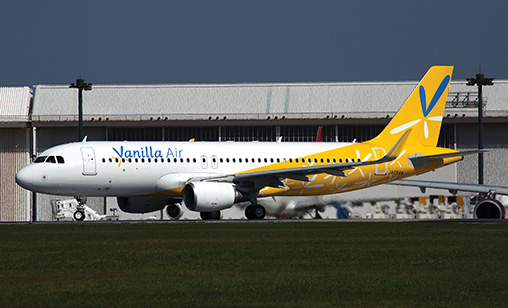News Backgrounder
LCCs take hold in Japan
December 1st 2014
In only 33 months, Japan’s commercial low-cost carrier (LCC) business has gone from zero to five budget operators, with added competition for customers from regional LCCs whose passengers are keen travelers to Japan. Read More »
The naysayers said it could not be done. Budget carriers and high-cost Japan won’t mix, they said. And they were partly right, but only partly.
So far, Kansai-based Peach, an All Nippon Airways (ANA affiliate and the airline that launched the LCC business in Japan), has been the sector’s star performer with a strategy that eventually sees international flights bringing in up to two thirds of the airline’s revenue. Not only was Peach the first LCC to fly in Japan, it was also the first budget airline to go into profit. In the fiscal year to March 31, it reported a net profit of 1.05 billion yen (US$8.88 million).
Peach’s first flights took off from Kansai airport at the beginning of March, 2012, to Sapporo and Fukuoka, respectively. By May the following year, it had carried two million passengers and expanded its network to six domestic and three international routes.
During the peak summer holiday period in July and August this year, cockpit crew shortages forced Peach to make mass flight cancellations that are estimated to have cost the carrier three billion yen.
 |
| Vanilla Air to fly daily between Narita and Tokyo from next month, with plans for a double daily service |
It operates 14 A320s, with six more of the type planned to be added to the fleet by year end in 2016. Peach said it intends to open a second base in Naha, Okinawa, to improve access and meet passenger demand for services to Southeast Asian destinations.
Jetstar Japan, a four partner venture whose principal shareholders are Japan Airlines (JAL) and the Qantas Group, announced an 11.1 billion yen loss for year to June 30, 2014. The Narita-based carrier has recorded a loss every year since it was launched in August 2012,
The major cause of Jetstar Japan’s continuing deficit was the delay in opening its second hub, in Kansai, which has now been approved. In early 2015, Jetstar Japan will be able start short to medium range international flights, which it had to delay until the Kansai base was approved. Until now, the LCC has concentrated on domestic flights. The young carrier is the fourth biggest airline in Japan after ANA, JAL and Skymark.
Another handicap for Jetstar Japan, and for any LCC based at Narita, is the airport’s 23.00-06.00 daily flight curfew, which corrupts the LCC model of around the clock high aircraft utilization.
Total revenue has increased 2.27 times to 29.1 billion yen. When the Kansai hub is up and running, Jetstar Japan will be the first local LCC to operate from two bases.
The curiously named Vanilla, a 100% subsidiary of ANA, was launched last year after AirAsia pulled out of a joint venture LCC with ANA, AirAsia Japan. ANA bought out AirAsia and renamed the airline Vanilla.
Based at Narita, Vanilla made a modest start, so the market was surprised when it launched three times a week Narita-Hong Kong flights in November. Vanilla plans to go daily with the service from February next year and later increase the frequency to double daily.
Outbound traffic on the route has been sluggish, declining by 20%, from 1.2 million in 2012 to one million in 2013. Vanilla’s president, Tomonori Ishii, thinks the new flights will increase traffic. Conversely, traffic from Hong Kong to Japan is “very strong”, with recent growth of 20%.
Japan’s fourth LCC, Spring Airlines Japan, launched services from Narita in early August with twice daily flights to Hiroshima and Saga and a daily round trip to Takamatsu. The new domestic airline is led by Shanghai-based Spring Airlines and minority Japanese investors.
The new airline, which is not linked to any Japanese carrier, has ambitious plans to launch international services in the 2015 North Atlantic Spring between Narita and up to 10 inland cities in China. Speaking to Japanese media in November, Spring Japan chairman, Wang Wei, said “Chinese tourists’ potential demand for visiting Japan was extremely high”.
“In comparison with to Korea and other countries, the number of Chinese visitors to Japan is still small even though Japan’s tourism resources are the richest among neighboring countries,” he said, and added the carrier is studying the feasibility of routes from Chongqing and Wuhan to Narita.
“If at first you don’t succeed, try again,” is the attitude AirAsia Group managing director, Tony Fernandes, has adopted for Japan. Fernandes has forged links with new Japanese partners and hopes to relaunch a Japan-based LCC for domestic and international services by July next year. Mid this year, AirAsia announced it would will be entering into a Shareholders Agreement with four new partners to establish Mark 2 AirAsia Japan.
They are Octave Japan Infrastructure Fund I GK (Octave), internet travel and financial services company Rakuten Inc., Noevir Holdings Co. Ltd, whose main businesses include cosmetics, pharmaceuticals, apparel and aviation and Alpen Co. Ltd, a sporting goods manufacturer and retailer, to establish AirAsia Japan. The Mark 2 AirAsia Japan team is proceeding through the necessary regulatory approval process to launch as scheduled next year.